
Conventional adhesive electrodes can damage the skin of neonates. PHOTO: VOISIN/PHANIE/GETTY IMAGES
Perspective piece
The risk factors that can result in the death of newborn infants depend greatly on whether they are born into the developed or the developing world. In the developed world, the infants at greatest risk either have complex malformations or inborn metabolic errors or are extremely preterm infants, at less than 24 weeks of gestation (barely half the normal period). They require a highly technological care environment with complex diagnostic and therapeutic measures . In the developing world, infants who are not so premature or critically ill die daily because basic maternal and neonatal care is not available. These infants face problems such as mild prematurity, birthing difficulties, and infections already overcome in structured health systems that fail to be implemented in poor or less developed countries or regions. The challenge in these areas is to translate what has already been achieved in the developed world in a meaningful and economically viable way. Monitoring of vital signs is essential to support the life of babies who are sick or preterm (or both) as soon as they are born.
Access the original article and any supplementary material here.